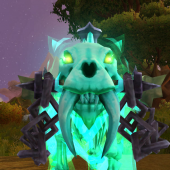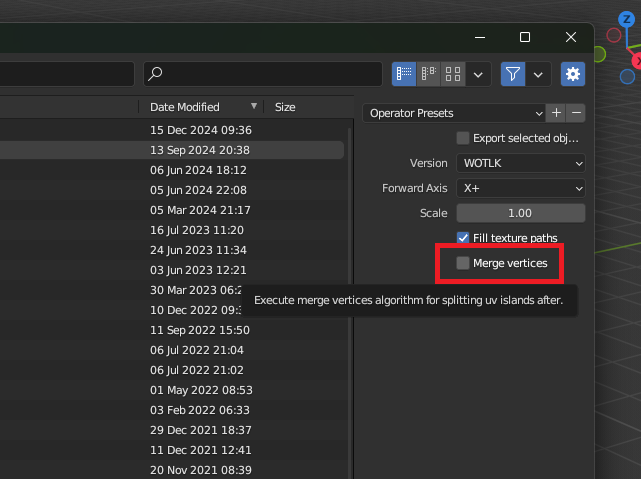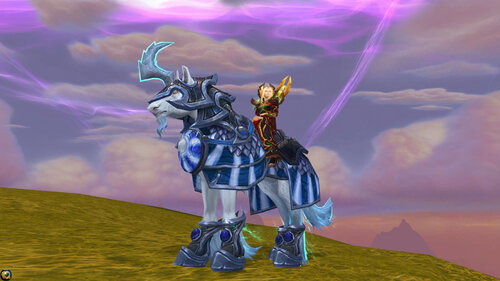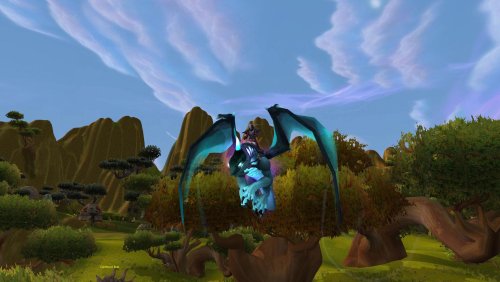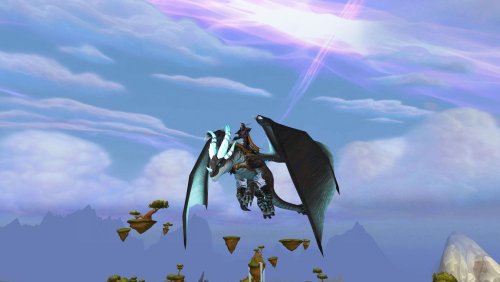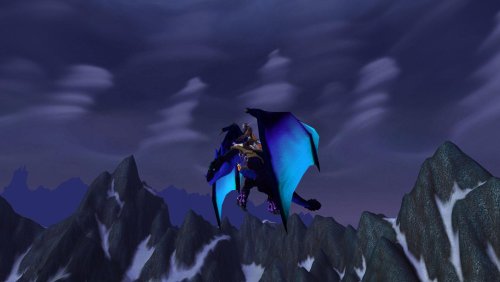-
Posts
13 -
Joined
-
Last visited
Recent Profile Visitors
The recent visitors block is disabled and is not being shown to other users.
Atraxian's Achievements

Private / Scout (1/14)
7
Reputation
-
I think it really depends on the kind of work you want to do. Most .m2 models are retroportable using a combination of a customized fork of the multiconverter, m2mod and wow blender studio. here is the copy of the multiconverter https://drive.google.com/file/d/1q7ZBpxGHTDU-Wmxl503LZJAhkYRXJrwA/view?usp=drive_link m2mod can be found here https://bitbucket.org/suncurio/m2mod/downloads/ Here is a link to an old forumpost with some explanation on the two previous softwares. And wow blender studio can be found on the wow blender studio discord. Other very important tools are Amaroth's templates for 010 Editor, especially those for the .m2 files (sometimes the new models will mix up the flying and swimming animations as in WotLK they were one and the same ans also have the Z source of the particles flippe, so they have to be changed by hand) If you are planning on working on .WMO models, things become much more ocmplicated as in mid Dragonflight Blizzard decided to change how materials were coded into the models and sometimes importing them in Blender will scramble the textures AND change the collision into an untextured polygonal model, so for those there is a whole lot of extra work to do and it's beyond my current abilities.
-
From what I see it looks like you left the "merge vertices" option ticked up in blender when exporting the model. Sometimes it screws up flat parts that have to show textures on both faces. when that happens, only one face per polygon will be shown (and if you rotate the model you will see the missing faces). Try to reopen the original model and re-export it removing the "merge vertices" option and see if it solves the issue. Otherwise you have to re-open your model and either change the rendering flags of the material to add "two-faced" or select each missing face and manually flip its normal
-
-
Version 1.3.0
318 downloads
Requisites: - Eluna module and AIO scripts on your core + client How to install: - copy Server_Talents into your lua_scripts folder in the core - add the content of client patch folder into a client patch How to use: - add the talent tabs for your class to the customTalentual.tabInfo variable declaration (the code has some examples for Druid and Mage) - add the spells for your class and tabs in customTalentual.talentualSpells you can selece the colimn and row of the spell and up to three required spells. NSx goes from 0 to 6 in order to show diagonal and bottom arrows for the talent tree NHx goes from 0 to 3 to show horizontal arrows IMPORTANT: the system will only work properly for spells that show up on your spellbook, so if you want to use a normal talent for this system, edit it with Stoneharry's spell editor and remove the DoNotDisplay flag from the spell. - to change the requisites for learning a talent and the number of available talent points look for the CheckRequisites and updatetalentpoints() functions respectively. At the moment it checks if you have at least 8 talent points spent to give you access to the fifth row and 20 talents spent to give you access to the 8th row and checks for at least one of the up to three requires spells for a talent. - left click to learn a talent - right click to forget a talent. If setup properly, forgetting a talent will automatically forget all other talents that no longer have correct dependancies. ADDING talents to the trees add a row in customTalentual.talentualSpells similar to the ones in the mage section, select one of the specializations in the square brackets -id: is the id of the spell -itemType = "spell" for reasons internal to the original scripts -row is the row where the spell will appear -column: is the column at which the spell will appear -TT: unused, I planned to use it as some extra customization, but never went around to doing it Now used to differentiate between kind of talent tabs, see changelog below -RSp1, RSp2, RSp3 = spell IDs of the required spells for the talent, you need to know ony one of them, 0 for no requirement -NSx = from 0 to 7 are the diagonal and down arrows to show in the talent tree -NHx = from 0 to 3 are horizontal arrow to show in the talent tree Hope you like it. Credits: Custom talent system using a modified version of the racialUI shared by awjerfaoiwejfoiajwe here (which in turn is a modified version of the lua custom store system) World of Warcraft 2024-10-26 08-50-27.mp4 -
Version 1.0.0
57 downloads
High resolution nether drakes. I used the body of the grotto nether drake and modified the wings of the dragon2 model to make them more similar to the old netherdrake models. In CreatureDisplayInfo.dbc use: Texture1 = body color texture Texture2 = glowing bits texture (horns and stripes) Texture 3 = saddle / armor texture It is a single model with the possibility to add armor, helm or saddle depending on the used geoset numbers in CreatureDisplayInfo.dbc In the CreatureGeosetData column use 0x23 for the mount without armor and saddle 0x21 for the mount with a saddle 0x22 for the mount with armor 0x11 for the mount with saddle and helm 0x12 for the mount with armor and helm I hope you like them -
-
Version 1.0.0
117 downloads
High resolution grand drakes made using the companion drake model (modified) plus the dragon2 wings and various pieces from other dragon models. Also rigged Tomkek's Onyxia drake mount to the old drake mount skeleton and swapped the wings. All models use 3 custom monster textures: Texture1 = skin Texture2 = horns and other ornaments Texture3 = saddle Models unclude: - Alexstrazsa from cataclysm Model: Drakemount2Grand.m2 Textures: AlexDrake_01.blp and AlexDrake_02.blp -Alexstrasza from Dragonflight Model: Drakemount2GrandAlex.m2 Textures: AlexDrake_01.blp and AlexDrake_02.blp - Malygos Model: Drakemount2grandmalygos.m2 Textures: MalygosDrake_01.blp and MalygosDrake_02.blp -Teracgosa Model: Drakemount2grandTerac.m2 Textures: TeracDrake_01.blp and TeracDrake_02.blp -Ysera Model: Drakemount2grandYsera.m2 Textures: YseraDrake_01.blp and YseraDrake_02.blp Textures: NightDrake_01.blp and NightDrake_02.blp (for nightmare version recolor) -Nozdormu Model: Drakemount2grandNozdormu.m2 Textures: NozdormuDrake_01.blp and NozdormuDrake_02.blp Textures: MurozondDrake_01.blp and MurozondDrake_02.blp (for infinite dragonflight recolor) -Halion Model: Drakemount2grandHalion.m2 Textures: HalionDrake_01.blp and HalionDrake_02.blp Textures: UltraxionDrake_01.blp and UltraxionDrake_02.blp (for blue recolor) -Onyxia (modified Tomkek's model) Model: Drakemount2grandOnyxia.m2 Textures: OnyxiaDrake_01.blp and OnyxiaDrake_02.blp Textures: NefarianDrake_01.blp and NefarianDrake_02.blp (for Nefarian's orange and yellow recolor) -Nefarian (modified Tomkek's model) Model: Drakemount2grandNefarian.m2 Textures: NefarianDrake_01.blp and NefarianDrake_02.blp Textures: OnyxiaDrake_01.blp and OnyxiaDrake_02.blp (for Onyxia's purple recolor) I hope you like them -
Version 1.0.0
154 downloads
Higher resolution models for the classic drakes, WotLK 3.3.5 Contains: - Drakemount2 folder: with various models for yout mounts (without armor, with armor + headgear and with armor + runes for the Azure drake) - Drake2 folder: with models for the regular drake mobs, if you want to switch them too. Textures to use in the dbc: - Custom creature Texture 1 = skin of the drake - Custom creature Texture 2 = used only for the Azure drake runes - Custom creature Texture 3 = used for the armor texture Just add the folders to an -mpq patch and add the models + texture choices to the creaturemodeldata.dbc and creaturedisplayinfo.dbc to start using them in in-game models. After seeing Tomkek's redesign of the Onyxian drake, I wanted to try and make a model that could be used for the old drakes and still kept most of their aesthetics intact. The higland drake model was a good start, but it really looked too "generic fantasy dragon" and missed most of the aesthetic choices that made wow classic drakes unique. I changed the wings for the wings in the Dragon2 models from Dragonflight, reshaped the head a little, reshaped the horns and for some models, added armor pieces, then rigged the meshes onto the old mounts' skeletons for animations. Then proceeded to modify the textures and recreate the colors that weren't already present (again thanks to Tomkek for both inspiration and the base texture for the crocodile scales back of the Onyxian drakel, I blatantly copy pasted it). The job might not be the best quality (this was my very first try at something more complex than retroporting models and fixing some minor issues. Texturework is amateurish at best and some animations might look a little wonky (especially the tail), but I still wanted to share the results. I hope you enjoy it. -
Sorry, but my knowledge stops at WotLK.
-
I didn't retroport it yet, but I can try later today. EDIT: seems to be working fine seems to be only missing the particles. They are actually there, but retroporting the model messed up the emitters parameters and they do not fly out of the mane of the creature (didn't have time to modify them by hand). Remember that for models with .anim files you have to run those files through the multiconverter too or some of the animations will be messed up. darkhoundmount.zip EDIT2: another thing I noticed is that the light coming from the eyes of the shoulderpads aren't animated. Probably need to look at whar mesh it is and animate it by hand in the .skin files.
-
What mounts are you trying to retroport? First thing I would try is to load the model with wowmodelviewer and see if the all the animations are broken or if the model animates correctly there. (put the model into an .mpq file and load the file with the WotLK / Pandaria version of wowmodelviewer). A thing I noticed when retroporting flying mounts is that some of the animation lookups get scrambled, probably because the new models have specific animation IDs for flying animations and WotLK models use the swimming animations IDs for flying. When that happens the model will use the idle animation or (sometimes) the swim backwards animation instead of the correct one. Is this what is happening to you? If that's the case, the only way I found to correct the issue is to load the retroported model with wowmodelviewer, look at all the animations, write down the IDs of the animations I'm looking for then load the .ms on 010 editor, pass it through the M2Template and manually fix the IDs and the Lookups of the animations by hand. May be something similar is happening to you.
-
Only thing I can think about is that you are not importing all of the helm models with the correct name. For example: Stag-Helm of Malorne, item id 29098 has DisplayId 46214 The model in the ItemDisplayId.dbc is "Helm_Leather_RaidDruid_D_01.mdx" But there actually is a model for each race and gender combination for example: helm_leather_raiddruid_d_01_nem.m2 (for Night Elf Male) helm_leather_raiddruid_d_01_nef.m2 (for Night Elf Female) helm_leather_raiddruid_d_01_tam.m2 (for Tauren Male) helm_leather_raiddruid_d_01_taf.m2 (for Tauren Female) Only thing I can think of is that the game is looking for a model for a race/gender combination that is not present in your mpq files.
-
Might not be the answer you were hoping for but some armor pieces have asymmetrical shoulders, you might want to look at one of them and compare it to other models. One of them is item number 23277, Lieutent Commander's Lamellar Shoulders EDIT: I'm assuming you are talking about WotLK 3.3.5a I took a little time to look at the Item.dbc and ItemDisplayInfo.dbc. In ItemDisplayInfo.dbc you have 2 different columns used for tho different models for right and left shoulder piece, so you can mix and match the models you want to display. Have you tried using only 1 model and leaving the other column empty?
-
If what you are asking is how to change the path of hardcoded textures in models, it is relatively simple. This is for models for 3.3.5a. I use 010 editor with Alastor's template (link at the end) ALWAYS MAKE A BACKUP OF THE MMODEL BEFORE STARTING. I know it's basic stuff, but you don't want to skip this, trust me. Just load the .m2 model with 010, run the template on the file and look at the result. You will find a section named "struct Textures" there you can open the textures you want to change: An important part is the enum E_TEXTURETYPES type value. Depending on it you can make the testure hardcoded (you have to specify the path inside of the model itsel) or being automatically taken fromexternal sources. For example monsters with multiple textures variations have MONSTER_SKIN_1, 2 and/or 3. These textures are taken from the Monster Texture Variation columns in the CreatureDisplayInfo.dbc I'm assuming you want to hardocde a texture or change the path of a hardcoded texture, so let's start with that. Click on the "string texture[xx]", you will notice that the upper part of the editor automatically went to the values of the texture path: You can change the texture path by rewriting the part on the right hand side, but you have to be EXTREMELY CAREFUL about two things: 1) the length of the path 2) the starting position of whatever comes after the texture Let's start with point 1: after you write in the new texture path, count the number of characters and input that number into the FileName_length section. Simple enough, right? Point 2 has 2 cases: SHORTER PATH THAN THE ORIGINAL fill in the path, then click on the hexadecimal part of the editor and start hitting 0 until you restore the next texture to its original position This is because the structure of the file has many many MANY points where it looks up the exact position of informations by using hardcoded offsets. If you change the length of something you run the risk of shifting everything and make the model unusable. LONGER PATH THAN THE ORIGINAL or NEW HARDCODED TEXTURE in this case you don't have enough room in this part of the file than before, but that's where the offset become your friends. You just have to insert the texture path at the end of the file and put the appropriate offset so the model knows where to look for it. First, go to the end of the file and fill in 0 until you start a new row, then put in the new texture path right click on the template result section and select column display format as hex, like this: now change the FileName_offset of your texture to the value on the left had side of the hex editor at the start of yout path row. In the example case it is 2D19C0h Return to showing things as Default or Decimal and change FileName_length to the appropriate number. This way you should have been able to hardcode or change a hardcoded texture with the 010 editor without going crazy. for reference: https://wowdev.wiki/M2#Textures for the template:
-
Just uploaded to the site: Also added some extra colors for variety. EDIT: forgot to mention that they work better with a 0.4 size scaling set in CreatureDisplayInfo.dbc


